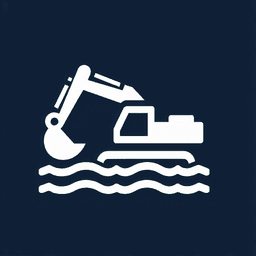
Dredging: Definition, Techniques, and Applications
February 27, 2025
Dredging
Dredging is a critical maritime process involving the removal of sediments and debris from the bottom of lakes, rivers, harbors, and other water bodies. This activity is essential for maintaining navigable waterways, ensuring safe passage for vessels, and preventing flooding in coastal areas.
Purpose and Importance: Dredging is primarily conducted to deepen waterways, allowing larger ships to pass through safely. It also helps in the construction of new ports and the expansion of existing ones. For sailors, dredging ensures that channels remain open and free from obstructions, which is vital for safe navigation.
Types of Dredging: There are several types of dredging, including mechanical dredging, which uses a bucket or scoop to remove material, and hydraulic dredging, which uses suction to move sediment. Each type is chosen based on the specific requirements of the project and the nature of the waterway.
Environmental Considerations: While dredging is necessary for maritime operations, it can have environmental impacts, such as disrupting marine habitats and releasing pollutants trapped in sediments. Therefore, it is often regulated and monitored to minimize ecological damage.
Technological Advances: Recent advancements in dredging technology have improved efficiency and reduced environmental impact. Innovations such as GPS-guided dredging equipment and real-time monitoring systems help ensure precision and minimize disruption to marine ecosystems.
For maritime users, understanding the process and implications of dredging is crucial for planning voyages and ensuring compliance with environmental regulations. It is a fundamental aspect of maritime infrastructure management, directly impacting the safety and efficiency of nautical operations.
Understanding Dredging in Maritime Context
Dredging is a crucial process in the maritime industry, involving the removal of sediments and debris from the bottom of lakes, rivers, harbors, and other water bodies. This process is essential for maintaining navigable waterways, preventing flooding, and facilitating the construction of maritime infrastructure.
Why is Dredging Important?
Dredging plays a vital role in ensuring that shipping lanes remain open and safe for navigation. It helps in maintaining the required depth of harbors and ports, allowing large vessels to dock and operate efficiently. Additionally, dredging is used to reclaim land, create new waterways, and support coastal development projects.
Types of Dredging Equipment
There are several types of dredging equipment used in the maritime industry, each suited for different tasks:
- Cutter Suction Dredgers: These are used for hard materials and are equipped with a rotating cutter head to loosen the material before suctioning it.
- Trailing Suction Hopper Dredgers: These are self-propelled vessels that collect sediments through trailing suction pipes and store them in hoppers.
- Backhoe Dredgers: These are used for precision dredging in confined areas and operate similarly to land-based backhoes.
Environmental Considerations
While dredging is necessary for maritime operations, it can have environmental impacts. It is important to conduct environmental assessments and implement measures to minimize harm to aquatic ecosystems. This includes careful planning and the use of environmentally friendly dredging techniques.
Future of Dredging
With advancements in technology, the future of dredging looks promising. Innovations such as automated dredging systems and real-time monitoring are making the process more efficient and environmentally sustainable. As global trade continues to grow, the demand for dredging services is expected to increase, highlighting its importance in the maritime industry.




